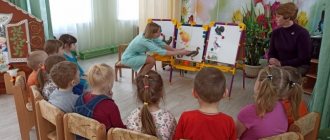The age of the child and the readiness of his speech apparatus
Schematically, a child’s speech development can be divided into stages.
Stage 1. Preparatory
The baby's age is up to 1 year. At this time, an important moment in the baby's development is humming and babbling. At first, sounds appear involuntarily, and by 5 months the child learns to imitate and respond to adults.
Stage 2. Pre-school
Lasts from 1 to 3 years. During this period, children begin to speak in monosyllabic phrases (instead of “Grandma, go,” they say “Baba, di”). Until the age of two, the vocabulary of objects and verbs increases (up to 24 months, the vocabulary is 90-100 words).
After two years, work begins on the quality of speech, and a clear pronunciation of most sounds is formed.
In the pre-preschool period, parents should contact a speech therapist if the child does not put words into short sentences.
Stage 3. Preschool
Lasts up to 7 years. By this age, the child’s active vocabulary includes 3000 words. At 3-4 years old, the baby can still replace some sounds (ts, ch with t), soften consonant sounds.
By the age of 5, softening should pass, whistling and hissing sounds are formed.
By the age of 6, the child learns to pronounce the sounds R and L, and complex, well-constructed sentences appear in speech.
Stage 4
At 7 years old, a child’s speech should be a full-fledged means of communication. Children not only pronounce all speech sounds correctly, but also distinguish them by ear and know how to analyze them. Conjunctions and allied words appear in speech; there are practically no errors in pronunciation. After several comments, the child analyzes the speech and corrects mistakes.
5th period. School
Lasts from 7 to 17 years. At this time, speech, both oral and written, is brought to perfection. The age period from 7 to 9 years is considered critical. This is explained by the fact that after 9 years of age, a child who has no experience of verbal communication becomes unable to learn.
By the age of 11, all phonetic errors in pronunciation disappear.
Activities with a child
First of all, you need to make sure that the child’s phonemic hearing is sufficiently developed, and if not, then you need to work on its development (for example, during the following exercises: determine whether this sound is in the word, where it stands - at the beginning, in the middle or in at the end of a word; come up with words with a given sound; select pictures whose titles contain it, etc.).
It is necessary to do articulatory gymnastics in the form of exercises and games. Such gymnastics should be done daily (or even better, several times a day) for 5-10 minutes. Adults show the baby certain movements of the lips and tongue, and then he controls himself using a mirror. Of course, only those who can pronounce this sound correctly can work with a child.
You can begin to correct the sound “ch” only if the sound “sh” is pronounced correctly, since the soft pronunciation of “sh” is an element of the correct pronunciation of “ch”. If the child pronounces “sh” correctly, then you can immediately start working on the “h” sound itself. At the moment of clearly pronouncing “th”, when the tongue is tense and raised to the upper teeth, you use a spatula, stick or just your finger to push it slightly back and up towards the alveoli. At the same time, lightly press the corners of your mouth with your fingers, thereby pushing your lips forward. With this position of the lips and tongue, instead of “t” you get “h”. The same exercise can be done by pronouncing not the sound “t”, but the syllable “at”, the syllable “ach” will be obtained.
We “set” the sound for the child. But from its single utterance, and even with outside help, there is still a long way to go to its correct use in speech. Let's move on to fixing (automating) sound. This is best done in reverse syllables: “ach”, “och”, “uch”, “ich”. Then the pronunciation is fixed between vowels (“acha”, “acho”, “achu”) in straight syllables. Next, you need to consolidate the sound in various words, phrases, poems.
After fixing the correct sound, work is carried out to distinguish it from others that are similar in sound. The sound “ch” can be mixed with “s”, “z”, “sh”, “zh”, “sch”, “ts”. The child’s attention should be drawn to the difference in the articulation of sounds and sound. First, teach him to distinguish isolated sounds, then the same ones as part of a syllable, word and sentence. In this work, special attention should be paid to words in which both sounds are mixed at the same time, for example: “student”, “inkwell”, etc. The child either repeats these difficult words for him after adults, or names pictures, or comes up with sentences .
Correct articulation of the sound Ch
When articulating the sound H, the speech apparatus is in the following positions:
- The lips are rounded and moved forward slightly.
- The teeth don't connect.
- The tip of the tongue, without straining, connects with the upper teeth. There should be a small gap between the tongue and teeth.
- There is a flow of air in the middle of the tongue, which is clearly felt when you bring your palm to your mouth.
- The soft palate rises and presses against the back wall of the pharynx, while the passage into the nasal cavity closes, air passes through the mouth.
- The vocal folds do not tense, nor do they move apart.
Age of the child and readiness of the speech apparatus
If a 3-4 year old child does not pronounce the sound and the letter CH, this is still within the normal range, since the articulation of the sound [CH] is complex:
- the tip of the tongue rises to the palate, bending like a hook so as to touch the alveoli of the upper teeth from the inside;
- for a short moment it sticks to the roof of your mouth;
- then the entire body of the tongue sharply falls down.
Such complex articulation of the sound [H] is available to children from 5 years old. The child is ready to pronounce it if he has already mastered the sounds , and [Ш].
Listen to the sound formation [H] and you will hear that the sound consists of soft [t'] and sharp [uh'].
Sound characteristics [H]:
The sound [CH'] is consonant, dull, always soft.
Setting the sound Ch
The sound Ch can be made in several ways:
- Start by pronouncing the soft sound t. Pronounce it quickly. In this case, the tongue should touch the tips of the upper teeth, then the tongue is slightly curled, as if stroking the bases of the upper teeth. At the same time, the corners of the lips are stretched into a smile.
- Alternately name the sounds t and sh. Do it quickly. At the same time, the lips are stretched into a smile again.
- To find the hole between the teeth from the inside, you can use a piece of paper. First, the hole is felt with your hands, and then paper is applied there. To hold it, you need to apply force - this is an excellent warm-up for the tongue.
Formation of grammatical structure of speech in preschool children
Sound production Methodological development in speech therapy (senior group)
Pronouncing the sound “Ch” often causes difficulties for children. To teach a child to pronounce it, you need to go through several stages.
Preparatory work
Work on any sound should begin with articulatory gymnastics. This will allow you to warm up the sore and get ready for work. For warming up, you can choose any gaming technique. Let's consider just a few options.
1. “Swing”: this exercise helps strengthen the muscles of the tongue and teach the child to control the tip of the tongue. The mouth is open, the lips are in a smile. The child alternately touches the top and bottom of the mouth with his tongue, then the upper and lower teeth, the place behind the upper and lower teeth.
2. “The tongue walks through the teeth” The mouth is open, the lips are in a smile. The child touches the outer and inner surfaces of the upper and lower teeth with his tongue.
You can also ask your child to clap his hands when he hears the sound “Ch.” Then you should first pronounce simply different sounds, then syllables and words. This technique will allow you to evaluate how well the baby recognizes the desired sound. If a child has better developed visual thinking, instead of words, offer him pictures with “H” in the name.
Setting the sound "Ch"
The sound “CH” consists of the sounds “Ш” and “Ть”. This means that a child who correctly pronounces the last two sounds will easily cope with pronouncing “Ch”. There are two ways to produce this sound.
1. The child must very quickly pronounce the combination of sounds “TH” and “SH”. It is very important that the lips are in a wide smile. 2. The child pronounces the sound “TH” very quickly, repeating it. First, the tongue should touch the base of the teeth from the inside, then you should gradually move it a little deeper, towards the alveoli. If you can’t learn to pronounce “Ch”, you can contact a speech therapist who will make the sound using a special probe.
To make sure that the sound is delivered, you should check how the child pronounces it in isolation. Game techniques are also used for this: the baby can be asked to imitate the passage of a clock using the sound “Ch” or to calm someone down (“Ch-Ch-Ch”). If everything is in order, you can start automation.
Automation of the sound "Ch"
Automation should be carried out taking into account the age of the child. With a baby, it is best to use pictures or toys; with older children, rhymes and songs are perfect. You should start by pronouncing syllables, and then gradually move on to words and sentences. In this case, you need to select such material so that the sound “Ch” appears in different positions. In any case, automation should take place in a playful way. There are a variety of games you can use.
1. “Songs with your favorite character.” It is necessary to choose any fairy-tale or cartoon character that is interesting to the child, and write on the cards the syllables containing the letter “H”. Then you need to offer the following task: “Your favorite hero decided to help you learn to pronounce “Ch” and prepared songs for you from the syllables. Sing along with him! Cha-cha-cha; Cho-cho-cho; Chu-chu-chu; Chi-chi-chi." It is very important that the child pronounces the “Ch” sound in a syllable correctly; only in this case can one move on to the next syllable. 2. "Echo". The child must repeat several words spoken by an adult in the same order, emphasizing the “Ch” sound. 3. "Offer". For this exercise, you can write a few words with the letter “C” on paper or use pictures. The child’s task is to make a sentence with each of them. 4. "Cubs" It should be suggested to name the cubs of various animals and birds (squirrels, hares, jackdaws, wolves), emphasizing the sound “Ch”. 5. "Confusion." The child is offered sets of letters from one word in a mixed order. His task is to collect the word and pronounce it.
Articulation gymnastics
It is best to perform all exercises in front of a mirror so that the child can see how he performs them. Each exercise is performed at least three times.
- “Window.” Pull your lips forward as much as possible and give them a square shape. Make sure that the corners of your lips do not touch each other.
- “Pancake.” Smile as widely as possible. Place your tongue on your lower lip, relax and count to 10. The tongue should stretch across the entire width of the lip, but you don’t need to reach it out too far, just enough to cover the lip.
- "Painter". Stretch your lips in a smile, open your mouth slightly, and reach your upper palate with your tongue. Make smooth movements, as if using a brush, from the teeth to the throat.
- “Brushing our teeth.” Smile and make movements with your tongue that imitate brushing your teeth. Be sure to ensure that your tongue reaches the gums and does not run along the bottom edge of the teeth.
- "Cup". Stretch your lips in a smile, stick out your tongue and reach your nose. Remain in position for up to 10 seconds.
- “Delicious food.” Open your mouth and lick your upper lip with your tongue. Movements should be made from top to bottom, not from side to side.
- "Air football" Pull out your lips with a tube. Blow on the cotton wool, but your cheeks should not swell. Blow for 10-15 seconds.
We recommend: Articulation gymnastics for the sounds Ш and Ж.
Summary of individual lesson “Automation of sound [H] in words and sentences”
Summary of individual lessons
Topic: “Automation of the sound [H] in words and sentences”
Goal: automation of the sound [H] in words, sentences"
Tasks:
1. Correctional and educational:
— clarify and consolidate articulation and correct pronunciation of the sound [H];
- practice the formation of nouns with a diminutive suffix;
— teach children to coordinate numerals with nouns.
2. Correctional and developmental:
— Development of attention and memory.
Equipment: picture - diagram of the sound “Ch”, pictures on this topic, box.
Progress:
1. Organizing time.
Today you and I will go traveling together with the sound “Ch”. But first, let's remember how to pronounce it correctly. Where is the tongue? What position are your lips in?
Show it on the diagram and draw the correct structure in squares.
Let's make the sound "Ch". Make sure that the tongue does not peek out of the window!
* Clarification of articulation:
lips are rounded and pushed slightly forward (tube),
the teeth are close together (slightly open),
the tip of the tongue on the tubercles,
the lateral edges of the tongue are tightly pressed to the upper molars,
under the pressure of exhaled air, the tip of the tongue comes off the palate.
The air stream is warm, intermittent, strong
Articulation gymnastics:
“Fence” - smile broadly, show clenched teeth (the upper teeth sit exactly on the lower ones). Hold this position for 5-7 seconds.
- “Elephant” - stretch your lips forward in a “tube” (teeth clenched). Hold this way for 5-7 seconds.
— Alternate exercises “Fence” and “Elephant”. The lower jaw does not move, only the lips move. Repeat 5-6 times.
- "Spatula"
- "Swing"
- “Candy” (hold the “glued” front part of the tongue against the upper palate).
2. Automation of the sound “Ch” in syllables.
Exercise "Chunga-Changa".
We sailed to the island of Chunga Changa.
Chang
tribe lives there , and they greet us in their Chang language. The Chang people greet us one by one. You need to respond to greetings, repeating after each of them. (The speech therapist points to the little man and reads out the first part of his speech, the child repeats the syllables after the adult.) Speech material:
| avcha | ancha | amcha | greedy | apcha | akcha | atcha |
| sheep | oncho | omcho | olcho | opcho | okcho | otcho |
| I'll teach you | unchu | I'll run away | I'll tell you | uppuchu | ukchu | I'll teach you |
| ivchi | inchi | imchi | ilchi | ipchi | ikchi | itchy |
| racing | hcha | bee | kcha | tcha | ||
| mcho | wcho | pcho | whoa | what | ||
| I'm rushing | I feel | bee | whoa | I feel | ||
| race | hchi | bees | kchi | tchi | ||
| mche | vche | bee | kche | Tche | ||
Meeting the inhabitants of the island:
3. "Tribe Gatherers"
They collect everything they find on the island. look and name what a resident of the Gatherer tribe found on the island (pictures)
Speech material:
butterfly, bee, cookies, barrel, teapot, fishing rod, stuffed animal, tap dance, ham, donut, shuttlecock, bell, scotch tape, mustard, glove, cucumber, cap, badges, pearls
Lip exercises
- “Grimaces of a Clown.” Keep your lips smiling. In this case, the lips should be tense, and the teeth should not be visible. The duration of the exercise is 15 seconds.
- “Fence.” Smile again, but at the same time close your teeth and expose them. Hold the position for 10 seconds.
- “Tube”. Pull your lips into a tube and hold for a third of a minute. The teeth don't connect.
- "Bagel". Round your lips and pull them forward slightly. Hold in position for 15 seconds.
To achieve good articulation, exercises need to be alternated, changing the sequence each time.
Exercises to develop exhalation
- The baby stands with his feet shoulder-width apart. While inhaling, he spreads his arms with his nose, while exhaling, he squats and hugs himself with his arms.
- Starting position is the same as in the previous exercise. Connect your hands in a “lock”, they are at the bottom. As you inhale, your arms rise up, while your breath is held. Then exhale very slowly, lowering your hands and saying “uh.”
- Puff out your cheeks to the maximum, hold for half a minute. Then pull your cheeks in and hold again for the same amount of time.
- Sit on a chair. Slowly lower and raise your hands, saying “Kaar”.
- Game-competition. Children compete to see who can growl the longest in one breath. (You can also compete to see who can hum the longest while exhaling.)
Tongue exercises
Language exercises are divided into static and dynamic.
Static complex:
- "Spatula". Relax your tongue and place it on your lower lip. Stay in this position for 10 seconds (the edge of the tongue should touch the corners of the lips).
- “The point of a needle.” Remove the tongue from the mouth, straighten and tense - the tongue at this time should be even and narrow.
- “Angry cat.” Place the tip of your tongue against your lower teeth and touch the middle of your tongue to your upper palate. Stay in the position for half a minute.
Exercises for home practice on pronouncing the letter P for children
Dynamic complex:
- “Punishment for the tongue.” Stick out your tongue and place it on your lower lip. Press your tongue with your lips and say five-five-five.
- “Watch.” Stick out your tongue and stretch it to one ear, then to the other. Keep the entire speech apparatus in tension.
- “Swing”. Stick out your tongue and pull it alternately towards your nose and chin.
- "Horse". Click your tongue, imitating the blows of a horseshoe. The middle of the tongue is always pressed to the palate.
- "Little Turkeys" Run your tongue back and forth across your upper lip so that you make the sound bl-bl. The speed of movement gradually increases.
One hundred thousand why
Close
Pronouncing the sound “Ch” often causes difficulties for children. To teach a child to pronounce it, you need to go through several stages.
Preparatory work
Work on any sound should begin with articulatory gymnastics. This will allow you to warm up and get ready for work. For warming up, you can choose any gaming technique. Let's consider just a few options.
1. “Swing”: this exercise helps strengthen the muscles of the tongue and teach the child to control the tip of the tongue. The mouth is open, the lips are in a smile. The child alternately touches the top and bottom of the mouth with his tongue, then the upper and lower teeth, the place behind the upper and lower teeth.
2. “The tongue walks through the teeth” The mouth is open, the lips are in a smile. The child touches the outer and inner surfaces of the upper and lower teeth with his tongue.
You can also ask your child to clap his hands when he hears the sound “Ch.” Then you should first pronounce simply different sounds, then syllables and words. This technique will allow you to evaluate how well the baby recognizes the desired sound. If a child has better developed visual thinking, instead of words, offer him pictures with “H” in the name.
Breathing exercises
Setting the sound "Ch"
The sound “CH” consists of the sounds “Ш” and “Ть”. This means that a child who correctly pronounces the last two sounds will easily cope with pronouncing “Ch”. There are two ways to produce this sound.
1. The child must very quickly pronounce the combination of sounds “TH” and “SH”. It is very important that the lips are in a wide smile. 2. The child pronounces the sound “TH” very quickly, repeating it. First, the tongue should touch the base of the teeth from the inside, then you should gradually move it a little deeper, towards the alveoli. If you can’t learn to pronounce “Ch”, you can contact a speech therapist who will make the sound using a special probe.
To make sure that the sound is delivered, you should check how the child pronounces it in isolation. Game techniques are also used for this: the baby can be asked to imitate the passage of a clock using the sound “Ch” or to calm someone down (“Ch-Ch-Ch”). If everything is in order, you can start automation.
Automation of the sound "Ch"
Automation should be carried out taking into account the age of the child. With a baby, it is best to use pictures or toys; with older children, rhymes and songs are perfect. You should start by pronouncing syllables, and then gradually move on to words and sentences. In this case, you need to select such material so that the sound “Ch” appears in different positions. In any case, automation should take place in a playful way. There are a variety of games you can use.
1. “Songs with your favorite character.” It is necessary to choose any fairy-tale or cartoon character that is interesting to the child, and write on the cards the syllables containing the letter “H”. Then you need to offer the following task: “Your favorite hero decided to help you learn to pronounce “Ch” and prepared songs for you from the syllables. Sing along with him! Cha-cha-cha; Cho-cho-cho; Chu-chu-chu; Chi-chi-chi." It is very important that the child pronounces the “Ch” sound in a syllable correctly; only in this case can one move on to the next syllable. 2. "Echo". The child must repeat several words spoken by an adult in the same order, emphasizing the “Ch” sound. 3. "Offer". For this exercise, you can write a few words with the letter “C” on paper or use pictures. The child’s task is to make a sentence with each of them. 4. "Cubs" It should be suggested to name the cubs of various animals and birds (squirrels, hares, jackdaws, wolves), emphasizing the sound “Ch”. 5. "Confusion." The child is offered sets of letters from one word in a mixed order. His task is to collect the word and pronounce it.
Staging and automation of the sound “Ш”
Share on social media networks
I like
Related posts:
Automation of sound
- Pronounce the sound h, clearly and intermittently.
- Say chchch, extending the sound.
- Game “Catch the Sound”. The adult names different sounds, and the child claps as soon as he hears the sound h. Then the exercise becomes more complicated - the adult pronounces not just sounds, but whole words.
- Game “Repeat”. The adult pronounces sounds, the child repeats them. It is important to ensure correct pronunciation. Example syllables: cha-cha-cha, chu-chu-chu, che-che-che, cho-cho-cho, chi-chi-chi.
- “Counting table.” Count the balls from 1 to 10, and then the keys (one ball, two balls, etc.).
- "Sweet Nothing". The adult says the word, the child calls it in a diminutive form. (Stump-stump, hand-handle, water-water).
- “Complex words and phrases.” Say the words lentil, tap dance, Chukchi, cap, and then phrases - mommy's cap, tea in a cup, Vanya's bunny, Anichkin's ball.
Staging and automation of sound [H]
Staging and automation of sound [CH].
Affricate, continuous (T, Sh: T - not lingual-dental, but lingual-alveolar; Ш - upper), voiceless, oral, occlusive-frictional.
Articulation is normal when spoken in isolation.
The lips are slightly pushed forward. The distance between the incisors (teeth) are compressed or brought closer together (2 - 3) mm. At the first moment, the tip of the tongue is pressed to the alveoli - a bow. At the second moment, the bow opens with an explosion and moves to the “upper” position. The lateral edges are pressed against the upper molars, the back and root are lowered. The entire tongue is shaped like a cup. The soft palate is raised and closes the passage to the nose. Vocal cords are open. You can see the position of the lips, that the tip of the tongue is at the top and the position of the lateral edges. You can feel the absence of vibration and the air flow as with C.
Staging. Hearing - visual analysis before sound, repeated repetition (Sh must be without defects). Tactile - vibration sensations. AS - AC (the tip of the tongue is not at the upper incisors, but at the alveoli - we move it further). We rely on the nature of the air stream. Mechanical way. On the C base, using a probe, spatula, finger. C must be free of defects. You place a spatula under the tip of your tongue: “Say C—the lips are not labialized, but when C—they are labialized. Don't rush to give the letter. Only when it is possible to remove the spatula.
Types of incorrect pronunciation. “Dental sigmatism” Ch=C. The tip of the tongue opens and falls down, not remaining in position with the sound “Sh”. Auditory - visual + tactile - vibration sensations with the sound Sh. Replacing Ch with Sh. The tip of the tongue does not form a connection with the alveoli, there is no jerky jet, only a solid one. This phoneme is acceptable according to the abbreviated system of phonemes, only before the sound “CH” is added. “Whistling sigmatism” Ch = C. The tip of the tongue is at the bottom, the back does the jerking work. Reinstall, but not on the basis of C. “Lateral sigmatism”. Cheeks swell, saliva splashes, side edges work; the tip of the tongue forms a bridge either with the alveoli or with the lower incisors, or closes the gap between the incisors. We set the sound again.
Automation of sound [H] . Correctly pronounce the sound [H] in syllables. CHA, CHO, CHU, CHI, CHE, CHA-CHO, CHA-CHO, CHA-CHI, CHA-CHE, CHO-CHA, CHO-CHO, CHO-CHI, CHO-CHE, CHO-CHA, CHU-CHO, CHOO-CHEE, CHOO-CHEE. We highlight the stressed syllables CHA CHA, CHA CHACHA, CHA CHA , CHA CHA CHA, CHACH CHA. We pronounce the sound CH in the words HOUR, MIRACLE, MONSTER, CAST IRON, PURITY, MAN, TOWET, STOCKING. We automate the sound [CH] between the vowel sounds ACHA, OCHO, UCHU, YCHI, ACHO, UCHA, OCHA, OCHU, ACHU. We pronounce the sound Ch in words. ROCKING CAIR, WASTE SHARPENER, SWING, COACH. Correctly pronounce the sound CH in combination with the consonant CHVO, CHVA, CHLO, CHMO, CHNO, CHRO, CHVA, CHLA, CHMA, CHNA, CHRA, CHWU, CHLU, CHMU, CHNU. We pronounce the sound Ch in words. DAUGHTER, BUMMET, POINT, NIGHT CLOUND. We pronounce the sound CH in the reverse syllable ACH, OC, UCH YCH. We pronounce the sound CH in words. DAUGHTER, NIGHT, ROOK, ROLLER, HOOP, BALL. We pronounce the sound [H] in sentences. ON THE ROOK TREE, MOTHER HAS A DAUGHTER, NIGHT HAS CAME.
Differentiation of sounds [h]-[t], [h]-[ts], [h]-[sch]
The easiest, but at the same time effective exercise.
Pronounce the following syllables in turn:
| tsa-cha-sha-ta | tso - what - what - that | tsu - chu - schu - tu |
| tsy - chi - cabbage soup - ti | tse -che - more - those | sha - cha - tsa - ta |
| what - what - so - then | schu - chu - tsu - tu | cabbage soup - chi - tsy - you |
| shche-che-tse-those | ats - ach - ash - at | ots - och - oshch - from |
| uts - uch - ush - ut | yats - yach - box - yat | its - ich - isch - it |
| ec - ech - yet - et | ash - ach - ats - at | oshch - och - ots - from |
| ush - uch - uts - ut | box - yach - yats - yat | isch -ich -its -it |
| yet - ech - ec - ut |




![Producing the sound [L] to a child in stages. Articulation gymnastics, speech therapy exercises, pronunciation lessons with pictures](https://doktorobrubov.ru/wp-content/uploads/postanovka-zvuka-l-rebenku-poetapno-artikulyacionnaya-gimnastika-logopedicheskie-uprazhneniya-uroki-330x140.jpg)



